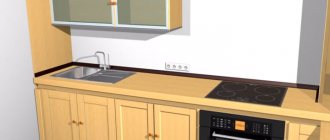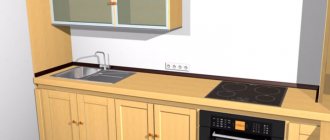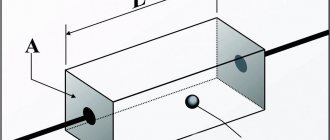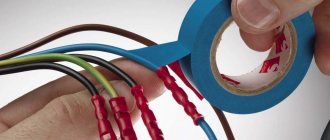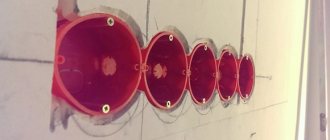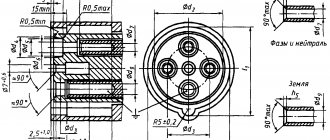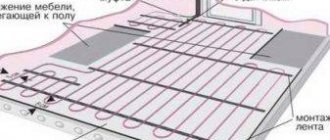Few people managed to avoid the problem of a lack of sockets in the apartment. This is especially true for houses built back in the days of the USSR, where the number of sockets in a room, the height and location of their installation were determined by some unknown rules from “secret manuscripts”, devoid of engineering justification and common sense. As a result, residents received sockets that seemed specially hidden behind cabinets and sofas and a “web” of additional extension cords stretching to the right places under sofas and carpets.
Although such measures were the only salvation then, they did not add safety, since an electric fireplace, iron, hair dryer and other powerful consumers of electrical energy could be “stuck” into one extension cord at the same time. And it’s very good if the circuit breaker in the panel was triggered, but this did not always happen. A real “saving straw” in such a situation can be a double socket, which is installed instead of a single socket in the same mounting box. In the article we will consider in what cases these devices can be installed, what types of devices exist, and we will analyze in detail the installation process itself.
Double socket
Advantages of double sockets - important to know!
By purchasing double sockets, users are guaranteed the following benefits:
- A double socket, internal and external, is more economical in financial terms compared to a single design;
- The product has compact ergonomic dimensions and looks aesthetically attractive;
- The presence of the accessory makes it possible to connect two household appliances at the same time.
Modern double sockets are available according to price criteria. The cost of the product depends on the purpose and functionality of the device.
Choosing the Right Method
The decision largely depends on the amount that the owners plan to spend.
Other factors are the power of devices that will be connected periodically or work constantly, the presence of decoration on the walls and the degree of readiness to disturb it. The best way is a star connection: either to the main panel or to the distribution box. For devices that are not very powerful, and which also will not operate hourly, a simple daisy chain connection is suitable. A major renovation or its immediate planning will provide an opportunity to modernize a house or apartment. In this case, they usually decide which devices are planned for purchase. It is this list of all future (and present) devices that will become an incentive for calculating the required cable cross-section, as well as choosing methods for connecting them.
Types of double sockets
Before making a choice and buying sockets, professionals recommend that you familiarize yourself with the quality characteristics, pros and cons, and criteria important for the productive operation of the accessory.
Mechanical protection
There are open and closed options. In a closed design, the connection elements are reliably protected, which is important if there are small children in the house. Open - a classic version of the product, found every day in homes, offices and other enterprises.
The cost of the open option is lower compared to the closed one. To ensure safety, the openings of open double sockets are closed with additional elements (plugs).
Double sockets with grounding
Double sockets with grounding are safe to use. When using the element, customers can be confident in their own safety. They will not be shocked or injured.
Correctly connected grounding contacts will make use comfortable.
Overhead and built-in
The surface-mounted double socket and the built-in socket differ in size and installation methods. The built-in option looks aesthetically attractive, matches the interior of the room, and is not annoying. External - easier to install, takes minimal installation time.
Housing tightness
The tightness of the housing can be determined by the markings. If the product indicates IP-45 or IP-55, the case has excellent strength parameters and is protected from moisture, dust and dirt. The higher the digital indicator, the more reliable and durable the overhead double socket.
For your information! Marking a product for leaks is important when purchasing a product for industrial enterprises operating at high capacities.
Additional functionality
Modern accessories may contain programming elements: timers, lights, sensors for connecting/disconnecting and others.
By giving preference to innovative options, the cost of the product can be several orders of magnitude higher.
Grounding purposes
In order to understand why you need grounding in an outlet, first of all, you need to become more familiar with the concept of grounding itself. By this term, experts understand the connection of current-conducting parts of electrical installations and household electrical appliances to the ground. The presence of such a contact makes it possible to reduce the potential of the housing of a faulty device (in the event of breakdown or damage to the insulation of internal circuits, for example) to a level that is safe for humans.
Due to the presence of an electrical connection to the ground, the accidental appearance of a dangerous potential on the metal body of a washing machine, for example, leads to an instantaneous reduction of it to a safe level. At the same time, it triggers automatic protection devices, which disconnect the power line from the distribution cabinet.
Characteristics of sockets by voltage and frequency
Popular and in demand among domestic users are sockets with a voltage of 220V for connecting electrical appliances with a power of 3.5 kW. The limitations are due to the fact that low-power equipment is not able to cope with current strength that goes beyond 16A.
Products with voltage parameters of 240 and 380V are also available for sale. The sockets are intended for use in industrial enterprises where the current strength approaches 32A.
When choosing a product, pay attention to the frequency of alternating current. In our country, European standards with indicators of 50 and 60Hz are considered common.
Construction device
In every apartment and country house, inconspicuous devices are installed that ensure the operation of a TV, electric kettle, washing machine, refrigerator and many other electrical appliances that are so necessary for people’s comfortable living. To avoid mistakes when choosing, you need to understand the characteristics of the products.
The main elements of the product are:
- frame;
- built-in fittings;
- cable for connecting the fittings to the power source.
The potential difference between the internal contacts contributes to the creation of voltage, which is the power source for absolutely all electrical appliances. Voltage is transmitted through special holes.
The structure of the fittings is as follows:
- The base is made of ceramic or plastic. Contacts are secured using metal plates.
- An additional function of the plates is as a place for screw fastening of cables.
- Popular models with a grounding function are available. They are equipped with an additional contact or plate.
- The structure is installed in a glass or attached to the back cover with rails. Depends on the type of installation.
An upper decorative overlay is required. It is screwed to the base using screws. Models with snap-on clip are available. Only in this form can the product be used safely.
Marking of sockets - description
Modern high-quality sockets have been improved to the maximum and have several protection parameters: from moisture, dust and dirt.
Marking is indicated by letter indicators (IP) and numbers:
- 0 – the product is not completely protected;
- 1 – protection against touching with fingers is provided and a ban on the penetration of solid particles larger than 5cm is provided;
- 2 - protection against touching with fingers and a ban on the penetration of solid particles with dimensions of 1.25 cm or more are provided;
- 3 – the socket is safe, provided with protection from accidental contact with power tools and other devices with dimensions larger than 2.5 mm;
- 4 – protection against penetration of solid particles with dimensions of 1 mm or more;
- 5 – the socket is partially protected from dust;
- 6 – maximum degree of protection, including against the ingress of microdust particles.
The second number indicated on the accessory indicates the degree of protection against moisture:
- 0 – device nodes are not protected;
- 1 – protection concerns vertical drops falling on the socket;
- 2 – protection concerns drops falling at an angle of 15 degrees;
- 3 – the device is protected from short circuiting when drops hit at different angles;
- 4 – the device is reliable, even if it gets splashed from the side;
- 5 – the presence of the second number 5 in the marking indicates that the socket can be washed, its operation is safe even if water enters the system without pressure;
- 6 – the device is capable of withstanding flows of water under pressure;
- 7 – it is allowed to immerse the element under water to a depth of no more than 1 m for a short time;
- 8 – deep diving is allowed;
- 9 – the device is completely sealed, it can be used under water for an unlimited time.
The indicated indicators are considered in relation to household appliances. There are also other markings indicating the strength of the case. They are rarely found on sale.
Fastening socket boxes
Before attaching the mounting box, you need to insert a wire into it. Next, the part is placed in the recess and fixed. Most models have holders (legs), which, when the corresponding screws are tightened, diverge to the sides, resting against the walls of the niche.
As practice has shown, such fasteners do not provide sufficient strength: the force acting on the socket when pulling the plug increases due to the lever and over time the fastening becomes loose.
Installation of socket boxes in a concrete/brick/aerated concrete wall
For greater reliability, you have to place the installation box on the solution. Any one will do - cement-sand, alabaster or gypsum. In order for the adhesion force between the solution and the niche to be maximum, the walls of the latter must first be moistened with water. The socket box is not installed immediately after laying the solution, but after 20 - 30 minutes, when it has set a little.
Having filled the gaps remaining between the box and the wall with the solution, remove the excess, and this completes the installation of this part of the socket.
Holders are not always included. When purchasing, you should immediately check whether the socket box is equipped with them, and if they are not found, these parts should be purchased separately.
The mounting boxes of inexpensive sockets are often secured using dowels. In this case, additional fastening with a solution is not required.
Installing a new outlet yourself
Connecting a double socket requires connecting 2 structural elements to a single line. The first loop contains 6 wires, the 2nd loop contains 3 main wires. As a result, the first one receives the current and transmits it to the second one.
Schematically, the installation of a new outlet looks like this:
- Before installing the product, the ends of the wires are cut using wire cutters, after shortening them by 1 cm, the insulation is stripped;
- The stranded wire is tightly twisted;
- The internal structure is installed tightly and evenly in the socket box, pressed against the wall;
- The product is screwed on and fixed.
Important! Incorrect wiring connections may result in a short circuit. If you lack experience, energy and time, it is better to use the help of professionals.
FAQ
Question No. 1: Which socket box is best to use for quick and high-quality installation?
It should be noted that the choice of socket box is no less important than the selection of the socket itself. Therefore, you should focus on designs from well-known brands, for example, Schneider Electric, which are distinguished by their reliability and high quality.
Question No. 2: Which method of fastening the socket provides greater reliability - clamping tabs or self-tapping screws?
Self-tapping screws become loose over time, as do the legs. However, the second option has proven itself to be a more effective method of fastening, since the clamps press the inner part against the walls of the “glass” with greater force.
Question #3: After creating branches, what is the best way to insulate the sleeve?
Insulation can be done using heat shrink tubing or electrical tape.
Question No. 4: Is grounding connected at once for the entire device or does each socket need its own grounding?
The grounding wire must be connected to each of the sockets available in the device.
Question No. 5: To which contact should the grounding conductor be connected?
The ground wire is connected to the center pin located on the bracket, usually marked with a corresponding symbol.
Photo of double socket
Panel
The front panel is secured with latches. To dismantle and install it back, it takes no more than 3 seconds.
Just pry it from the side with a screwdriver and pull it out with your fingers.
There is even a marking in which places you need to pry with a screwdriver.
Put it in place in the same way, pressing and snapping it into place at the fastening points.
However, if you come across a fake whose plastic elasticity deteriorates over time, these latches can turn from a plus into a minus.
After a couple of years, when dismantling, you may forget how they initially snapped into place and accidentally break them.
Traditional bezel mounting requires longer dismantling. You will have to unscrew the mounting screw, and maybe even more than one.
And if you perform such an operation quite often, then it is quite possible to ruin the thread. After which, you will have to replace not the socket, but the entire socket.
If you plan to use sockets and switches even at the finishing stage, then it is better to choose mechanisms with protective covers.
Firstly, they protect the products during transportation. And secondly, they allow you to paint walls and hang wallpaper even without dismantling the front panels.
Materials
When choosing materials, manufacturers take into account their resistance to fire. The socket body is predominantly made of heat-resistant plastic. The terminals and contacts are made of low resistance metal. Such alloys are reliable, can withstand high temperatures and are not susceptible to corrosion.
Copper, brass and bronze contacts are the most common options. The bases for attaching the contacts inside the socket are made of plastic or ceramic.
The material protects the terminals from overheating and is an insulator. Ceramic pads are more reliable.
Installation features
There are special features when connecting a computer double socket. The product contains two terminals and one outlet for wires. For this reason, it would be more rational to use a parallel connection.
The total current must not exceed 16 A. The connection cable must have the same cross-section and material as the main wiring. These parameters apply to the power outlet for computer equipment.
There are also double sockets for connecting to the Internet with an RJ-45 connector. Usually these two types are not combined into one design, because there will be interference.
Overlay frame
Frames in good sockets are attached independently of the front panels. This allows you to freely dismantle and install them.
In older series, the frame is secured and tightened by the front panel. Therefore, in them, replacing the frame with another of the same type, but of a different color, occurs only simultaneously with the panel.
In this case, it will be better if such products are two-layer.
- outside – ABS plastic
- reverse inner side - reliable polycarbonate
Inside the panel there are latches, due to which the fixation on the mechanism occurs. Please note that they may have several marks.
This will make it easy to align the frames in case of slight unevenness in the walls.
Internal insulation
A high-quality socket, even with the front panel removed, ensures complete electrical safety.
All internal current-carrying parts are securely closed and insulated. There is no access to them.
In sockets of the budget series, there are always clearly open live parts.
And if you work with a screwdriver that does not have an insulated tip, then you may well either get energized or accidentally overlap the phase and the grounded body with the tip itself.
Curtains
In accordance with safety regulations, all sockets installed in living rooms must have protective curtains. How do good sockets differ in this regard from cheaper ones?
In budget products, the curtain mechanism is fixed directly to the back of the front panel.
Very often, the following problem arises due to such curtains. There are combination type forks. That is, part of the fork legs are insulated with plastic, and the ends themselves are metal.
Most often, such plugs are used in various types of chargers. Their metal ends are slightly thicker than the middle part of the contact legs.
This plug plugs into a regular outlet without any problems. But when you try to remove it and pull it out, the protective curtains bite the contacts like a guillotine.
Biting occurs precisely at the boundary of the plastic-metal transition of materials. As a result, the plug gets stuck in the socket.
And to pull it out you have to put in extra effort. Often this all ends with a break in the protective curtains.
In a good modern socket, the shutter mechanism is recessed deep into the body, and not located on the back side.
Accordingly, such a problem as biting the fork simply does not exist. Any fork goes in and out of it very smoothly.


